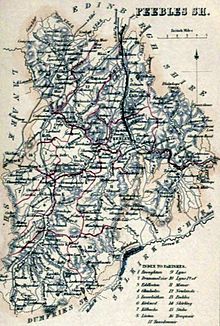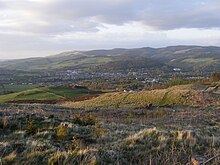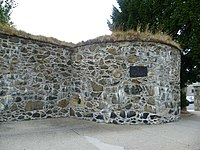Human settlement in Scotland
Peebles
| |
|---|---|
| An aerial view of Peebles | |
 Peebles' Coat of Arms Peebles' Coat of Arms | |
 | |
| Area | 3.85 km (1.49 sq mi) |
| Population | 9,000 (2022) |
| • Density | 2,338/km (6,060/sq mi) |
| OS grid reference | NT2540 |
| • Edinburgh | 21 mi (34 km) |
| • London | 313 mi (504 km) |
| Council area | |
| Lieutenancy area | |
| Country | Scotland |
| Sovereign state | United Kingdom |
| Post town | PEEBLES |
| Postcode district | EH45 |
| Dialling code | 01721 |
| Police | Scotland |
| Fire | Scottish |
| Ambulance | Scottish |
| UK Parliament | |
| Scottish Parliament | |
| 55°39′07″N 03°11′20″W / 55.65194°N 3.18889°W / 55.65194; -3.18889 | |
Peebles (Scottish Gaelic: Na Pùballan) is a town in the Scottish Borders, Scotland. It was historically a royal burgh and the county town of Peeblesshire. According to the 2011 census, the population was 8,376 and the estimated population in June 2018 was 9,000.
History
Initially, a market town, Peebles played a role in the woollen industry of the Borders during the 19th and early 20th centuries. Most mills had closed by the 1960s, although the last one remained open until 2015. The character of Peebles has changed; the town serves as home to many people who commute to work in Edinburgh, as well as being a popular tourist destination, especially in the summer. In the mid-to-late 19th century health tourism flourished, centring on hydropathic establishments, which over time morphed into a hotel format, with Peebles Hydro Hotel being one of the few survivors of that era. Notable buildings in the town include the Old Parish Church of Peebles and Neidpath Castle. Other local attractions include a museum and the Kailzie Gardens. Peebles has won multiple awards for the range of shops on its High Street.
Historic features and traditions


The oldest building in Peebles is the tower of St Andrew's Church. The church was founded in 1195. It was destroyed (along with many other Borders abbeys and priories) by the soldiers of Henry VIII. The stones of the ruins were pilfered for many other local buildings leaving only the tower standing amongst the gravestones of the churchyard. Another ancient church in the town is the Cross Kirk, founded in 1261. Although now mainly ruins, the Cross Kirk plays a prominent part in the local festival.
The annual local festival in Peebles is called the Beltane, and involves (as with many Borders festivals) a Common Riding. The Beltane, proclaimed at the cross, culminates with the crowning of the Beltane Queen (a girl chosen from one of three local primary schools) along with her court, including the likes of the First and Second Courtiers, Sword Bearer and Standard Bearer; on the steps in front of the parish church. The adult principal of the festival is the Cornet, a local young man chosen by the organizing committee on a basis of being considered worthy of representing the town, who then carries the town standard for a year.
To the west of the town is Neidpath Castle, which can be reached on foot through Hay Lodge Park; the route has views of the castle. The castle is now closed to the public.
On the south side of the High Street are the old burgh offices. These incorporate the town's library, art gallery, and local museum. The building occupied by these is called the Chambers Institution, being deeded to the town by William Chambers, a member of the Chambers publishing family who originated in the town. Chambers' house can be found on the oldest street in Peebles – Biggiesknowe. Peebles tolbooth, the civic centre of the medieval burgh, is the only medieval tolbooth site in Scotland to have been excavated by archaeologists.
Peebles is no longer connected to the railway network. In years past, the Symington, Biggar and Broughton Railway had lines that connected Peebles to Edinburgh and Galashiels, with a goods station and Peebles and Peebles West stations. A connection to Edinburgh is maintained by Borders Buses service X62.
Historically Peebles and the Scottish borders have been the location of many textile businesses. Still today, March Street Mills is the location of Robert Noble along with its sister company Replin Fabrics.
Coat of arms

The arms of the Royal Burgh of Peebles feature three salmon on a red field. The heraldic blazon is: Gules, three salmons counter-naiant in pale proper. The motto is Contra Nando Incrementum, Latin for "There is growth by swimming against the stream", referring to the annual migration of salmon up the River Tweed in order to breed. The one salmon facing forwards and two facing backwards represent the fact that for every salmon that goes up the river, two come back to the sea.
The arms are very old, first appearing on the town's mercat cross, which was built sometime before 1320. Originally the colours were not standardised, the background variously appearing as blue, green or red. The last seems to have been most common, and it was red that was chosen when the arms were formally granted by Lord Lyon in 1894, following a petition from the town clerk, William Buchan, who had previously received a letter from A. C. Fox-Davies questioning the burgh's right to use the arms.
After the abolition of the old Scottish burghs in 1975, the arms became redundant. In 1988 they were regranted to the Royal Burgh of Peebles and District Community Council, who continue to use the arms today, with the addition of a community council's coronet. The traditional province of Ångermanland in Sweden also has a very similar coat of arms, but with a blue background.
Location

Peebles lies at the confluence of the River Tweed and Eddleston Water (locally called "the Cuddy"). The Tweed flows west to east, and the Eddleston flows from the north, turning to flow southwest 300 yd (270 m) before the confluence. This south-westerly turn demarcates a raised triangular piece of land, open to the east but contained by the rivers to the south and north. The name is generally accepted to come from the Brythonic pebyll tents, signifying a temporary settlement.
From around 1570, the eastern side was defended by a town wall, which ran in an east-facing arc, through which the road to Glentress passed at the East Gate. The road passing through this gate, the Eastgate, is one of four gates in Peebles, the others being Northgate, Bridgegate (where the Eddleston Water was crossed to the north of town), and Ludgate (the western gate of the town), now called Young Street.
At the junction of Eastgate and Northgate roads, where the Eastgate becomes High Street, is an ancient market cross. The present-day market is held in a car park adjacent to the site of the former railway station, at the north and south ends of which are the remains of the town wall. Peebles High Street runs parallel with the Tweed along the spine of a ridge, at the west end of which is the parish church.
Facilities

In 2014 Creative Scotland named Peebles the most creative place of its size in Scotland, presenting the town with a Creative Place Award and £100,000 to enhance arts events, festivals, and arts commissions. Most arts performances take place in the Eastgate Theatre on the High Street which has a year-round programme of music, drama, dance, talks, and classes for children and adults. The town also has four major annual festivals – the Beltane Festival, Peebles Arts Festival, Tweedlove Bike Festival, and Imaginarium.
Peebles is a popular centre for walkers, cyclists, and horse riders. It is the eastern terminus of the John Buchan Way, a 22-kilometre (14 mi) walking route which runs between Peebles and Broughton. The Cross Borders Drove Road, an 82-kilometre (51 mi) route between Hawick and Little Vantage, also passes through the town.
The town is home to two long-established Scottish senior sporting clubs. Peebles Rovers F.C. provides Peebles with a senior Football team in the East of Scotland Football League, meanwhile Peebles RFC currently represent the town in Scottish National League Division Two in the Scottish Rugby pyramid system.
Peebles has an 18-hole golf course located at the upper end of Kirkland Street. The golf club was formerly owned and run by the local council before being taken over and run by its own members.
Peebles has three primary schools: Kingsland (now relocated to Neidpath Road from its original position on Rosetta Road), Priorsford, and the Roman Catholic Halyrude Primary School (now relocated from Elcho Street to the former Kingsland primary school building on Rosetta road). Peebles also has the largest secondary school in the Borders, Peebles High School, which is attended by pupils from all over Tweeddale.
In 2005, a study by the New Economics Foundation ranked Peebles as the best town in Scotland (second best in the UK, after Hebden Bridge in Yorkshire) for a range of independent shops and 'home town identity'.
The local health facility is Hay Lodge Hospital in Neidpath Road.
Notable people
- David Ballantyne (1914–1997), cricketer
- John Bathgate (1809–1886), New Zealand politician who grew up in Peebles
- Eric Bogle (b. 1944), Folk musician resident in Australia, born in Peebles
- Scott Brash (b. 1985), Olympic gold medallist
- John Buchan (1875–1940), author and politician with close family links to the town
- Robert Chambers (1802–1871), publisher and author of Vestiges of the Natural History of Creation
- William Chambers (1800–1883), publisher, brother of Robert
- Finlay Christie, New Zealand rugby player born in Peebles
- Brian Cook (football administrator) (b. 1955), Australian football administrator, born in Peebles
- Bill Gilmour (b. 1939), Film and Television Producer/Director.
- James Grieve (1841–1924), horticulturist and namesake of the James Grieve apple, born in Peebles
- Sir Robert J. M. Inglis (1881–1962) railway engineer
- O. Douglas (Anna Masterton Buchan) (1877–1948), novelist; Priorsford, in her novels, is based on Peebles
- William Keddie (1809–1877) scientist and creator of the Scottish Sunday School system
- Charles Leedham-Green Mathematician at QMUL, famous for his work on computational group theory
- John Mathison (1901–1982), New Zealand MP born in Peebles
- Ernest Maylard (1855–1947) surgeon and mountaineer, retired to Peebles and is buried there
- B. N. H. Orphoot (1880–1964) architect
- Mungo Park (1771–1806), practised medicine, and his house on the north of the Cuddy bears a commemorative plaque
- Alexander William Stewart (1868–1933), a naval architect, engineer, and inventor
- Catherine Maxwell Stuart, 21st Lady of Traquair (born 1964), born in Peebles
- Kevin Thomson (b. 1984), footballer who grew up in Peebles
- Marioun Twedy (fl. 1649), accused of witchcraft in Peebles.
- John Veitch (1829–1894), philosopher and poet, born in Peebles
Twin town

 Hendaye, Basque Country, Pyrénées-Atlantiques, France
Hendaye, Basque Country, Pyrénées-Atlantiques, France
Gallery
-
 High Street looking towards Eastgate (2018).
High Street looking towards Eastgate (2018).
-
 River Tweed looking downstream (2018).
River Tweed looking downstream (2018).
-
 River Tweed looking upstream and towards the town (2018).
River Tweed looking upstream and towards the town (2018).
-
 Remains of the town wall corner bastion.
Remains of the town wall corner bastion.
-
 Witch hunt commemorative plaque on Tweed Green in Peebles
Witch hunt commemorative plaque on Tweed Green in Peebles
-
 Commemorative plaque reads: "In memory of all those in Peebleshire persecuted under the 1563 Witchcraft Act including these 27 executed in 1629."
Commemorative plaque reads: "In memory of all those in Peebleshire persecuted under the 1563 Witchcraft Act including these 27 executed in 1629."
See also
References
- "Peebles (Scottish Borders, Scotland, United Kingdom) – Population Statistics, Charts, Map, Location, Weather and Web Information". www.citypopulation.de. Retrieved 4 April 2019.
- "Mid-2020 Population Estimates for Settlements and Localities in Scotland". National Records of Scotland. 31 March 2022. Retrieved 31 March 2022.
- "An Stòr-dàta Briathrachais" (in Scottish Gaelic). University of the Highlands and Islands. Retrieved 24 November 2011.
- "Populations of Borders Towns & Village". www.ourscottishborders.com. Retrieved 8 January 2017.
- "Peebles (Scottish Borders, Scotland, United Kingdom) - Population Statistics, Charts, Map, Location, Weather and Web Information". www.citypopulation.de. Retrieved 3 July 2020.
- "Mr Walter Thorburn, MP". www.historyofpeebles.com. Retrieved 28 July 2016.
- "Job losses as Robert Noble mill in Peebles to close". BBC News. 14 July 2015. Retrieved 28 July 2016.
- Bradley, James; Dupree, Marguerite; Durie, Alastair (1997). "Taking the Water Cure: The Hydropathic Movement in Scotland, 1840–1940" (PDF). Business and Economic History. 26 (2): 426–437. Archived from the original (PDF) on 29 April 2005. Retrieved 16 November 2011.
- Scott, Hew (1915). Fasti ecclesiæ scoticanæ; the succession of ministers in the Church of Scotland from the reformation. Vol. 1. Edinburgh : Oliver and Boyd. pp. 285-289.
- "Vol 2 (2003): The origins of settlements at Kelso and Peebles, Scottish Borders archaeological excavations in Wester and Easter Kelso and Cuddyside/Bridgegate, Peebles by the Border Burghs Archaeology Project and the Scottish Urban Archaeological Trust, 1983--1994 | Scottish Archaeological Internet Reports". journals.socantscot.org. Retrieved 26 July 2021.
- Marquis of Bute, John (1896). The Arms of the Royal and Parliamentary Burghs of Scotland. William Blackwood & Sons. p. 310.
- Urquhart, R.M. Scottish Burgh and County Heraldry (1973 ed.). Heraldry Today. p. 230. consulted 19 December 2013.
- "Royal Burgh of Peebles and District Community Council, Scottish Borders". Heraldry Society of Scotland. Retrieved 25 January 2015.
- Pringle, George C. (1914). "County and Shire – The Origins of Peebles and Selkirk". Peebles and Selkirk. Cambridge University Press. Retrieved 16 November 2011.
- "Peebles". The Gazetteer for Scotland. Retrieved 26 June 2022.
- "Peebles Creative Place 2014".
- "John Buchan Way". Scottish Borders Council. Retrieved 26 June 2022.
- "Cross Border Routes". South of Scotland Countryside Trails. Retrieved 26 June 2022.
- "Halyrude Primary in Peebles upgrade officially opened". BBC News. 14 September 2011. Retrieved 12 February 2024.
- Carvel, John (6 June 2005). "Retail chains 'cloning' UK towns". The Guardian. Retrieved 16 November 2011.
- "Hawick Community Hospital". Historic Hospitals. 26 April 2015. Retrieved 5 February 2020.
- "Obituary". Evening Star. No. 7014. 22 September 1886. p. 2. Retrieved 16 September 2019.
- "Famous PeebleansPeebles - The Royal Burgh : Visit and discover the County Town of Peeblesshire. The official website". www.peebles-theroyalburgh.info. Retrieved 13 February 2024.
- Stott, Louis (2004). "Oxford Dictionary of National Biography". Oxford Dictionary of National Biography (online ed.). OUP. doi:10.1093/ref:odnb/61010. ISBN 978-0-19-861412-8. Retrieved 8 April 2022. (Subscription or UK public library membership required.)
Further reading
- Joe Brown and Iain Lawson (1990), History of Peebles: 1850–1990. Mainstream.
- Chambers, William (1843). A History of Peeblesshire (8th ed.). Edinburgh & London: William and Robert Chambers. Retrieved 6 December 2009. Full text at Google Books.
External links
 Media related to Peebles at Wikimedia Commons
Media related to Peebles at Wikimedia Commons
| River Tweed, Great Britain | |
|---|---|
| Administrative areas | |
| Flows into | |
| Towns (upstream to downstream) | |
| Major tributaries (upstream to downstream by confluence) | |
| Major bridges (upstream to downstream) |
|